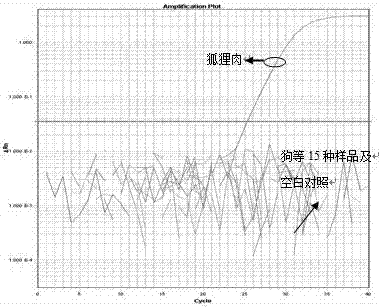Primers, probe, method and kit for accurate quantitative digital PCR detection of fox-derived component
A source component, quantitative detection technology, applied in biochemical equipment and methods, microbial measurement/inspection, DNA/RNA fragments, etc., can solve the deviation of quantitative results of amplification efficiency, the accuracy error of template copy number, and improve detection Cost and other issues, to achieve stable and reliable results, reliable results, accurate and sensitive results
- Summary
- Abstract
- Description
- Claims
- Application Information
AI Technical Summary
Problems solved by technology
Method used
Image
Examples
Embodiment 1
[0025] In this example, the fox primer pair and probe specificity were evaluated by the following test.
[0026] The inventor of the present invention detects the fox F2 gene sequence by real-time fluorescent PCR (probe method) for the first time, and can determine the specificity of the fox primer probe combination. The reaction system is: 2×TaqMan Universal PCR Master Mix 12.5 μL; probe (10 μM) 0.5 μL; upstream and downstream primers (10 μM) each 1 μL; template DNA 5 μL; add ddH 2 O to a total volume of 25 μL. The reaction program is 95°C 10 min; 95°C 15 s; 60°C 1 min, 40 cycles.
[0027] The primers and probe sequences used to detect fox-derived components are:
[0028] The primer sequence is SEQ ID No.1 and SEQ ID No.2, the probe sequence is SEQ ID No.3, a fluorescence quenching group BHQ1 is attached to the 3'end of the probe, and a fluorescence is attached to the 5'end Report group FAM.
[0029] The main testing instruments used:
[0030] Micropipette (10 µL, 100 µL, 1000 µL, E...
Embodiment 2
[0056] In this example, the fox F2 gene primer pair and probe were used in the following experiment to quantitatively detect the copy number of the fox gene and evaluate the sensitivity of the fox primer probe by digital PCR.
[0057] The inventor of the present invention detects the fox F2 gene sequence through digital PCR (probe method) for the first time, and can determine the specificity of the fox primer probe combination. The reaction system is: 2 × ddPCR Master Mix (Bio-Rad, USA) 10 μL; probe (10 μM) 0.5 μL; upstream and downstream primers (10 μM) each 1 μL; template DNA 5 μL; add ddH 2 O to a total volume of 20 μL. The reaction program is 95°C, 5 min (1°C / s); 94°C 15 s, 60°C 1 min (1°C / s), 50 cycles; 98°C 10 min (1°C / s). After the amplification, the copy number of fox F2 gene was read by a droplet analyzer.
[0058] The primers and probe sequences used to detect fox-derived components are:
[0059] The primer sequence is SEQ ID No.1 and SEQ ID No.2, the probe sequence is SE...
Embodiment 3
[0089] This embodiment provides a kit for accurately quantifying gene copy numbers of fox-derived components. The kit includes specific oligonucleotide primer pairs and probes for quantitative detection of fox-derived components in the digital PCR method of the present invention, and instructions for use. The kit includes primer pair SEQ ID No. 1, SEQ ID No. 2 and probe SEQ ID No. 3, the 3'end of the probe is connected with a fluorescence quenching group BHQ1, and the 5'end is connected with a fluorescent Reporter group FAM, the PCR amplification conditions are given in the instruction manual, and the conditions are 95℃, 5min (1℃ / s); 94℃ 15 s, 60℃ 1 min (1℃ / s) , A total of 50 cycles; 98°C for 10 min (1°C / s). For different instruments, the reaction parameters should be adjusted appropriately.
[0090] In order to ensure the feasibility of the established method, four commercially available samples were selected, including mutton rolls, donkey slices, meat sausages, beef rolls, e...
PUM
 Login to View More
Login to View More Abstract
Description
Claims
Application Information
 Login to View More
Login to View More - R&D
- Intellectual Property
- Life Sciences
- Materials
- Tech Scout
- Unparalleled Data Quality
- Higher Quality Content
- 60% Fewer Hallucinations
Browse by: Latest US Patents, China's latest patents, Technical Efficacy Thesaurus, Application Domain, Technology Topic, Popular Technical Reports.
© 2025 PatSnap. All rights reserved.Legal|Privacy policy|Modern Slavery Act Transparency Statement|Sitemap|About US| Contact US: help@patsnap.com



